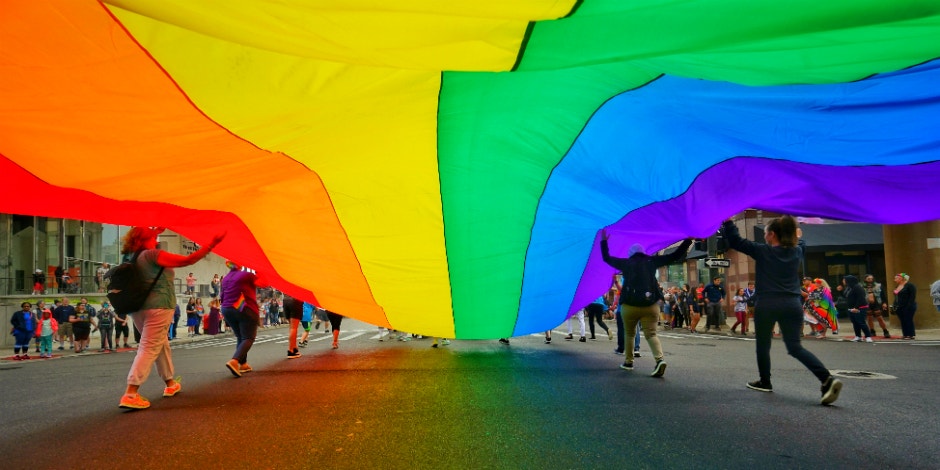How The Rainbow Became The Symbol Of LGBT Pride
It was originally eight colors.
 getty
getty By Jacob Shamsian
June is LGBT pride month in the United States, so you may be seeing rainbows everywhere. But why rainbows, of all symbols? Why not other color combinations? Why a color combination at all, and not some kind of shape as a logo instead?
The LGBT rainbow and pride flag was invented in 1978 by Gilbert Baker, a gay rights activist, army veteran, artist, and self-styled "gay Betsy Ross." (Baker died in March of 2017.) He made the flag for the Gay Freedom Pride Parade that year in San Francisco, at the request of Harvey Milk, a gay city politician who was assassinated later that year.
The symbol for gay pride took hold immediately.
"We stood there and watched and saw the flags, and their faces lit up," Cleve Jones, an LGBT rights activist present at the parade, told The New York Times. "It needed no explanation. People knew immediately that it was our flag."
The flag has changed over the years. The contemporary version has six colors, but the original had eight. Each color had its own symbolic meaning:
- Pink: Sex
- Red: Life
- Orange: Healing
- Yellow: Sunlight
- Green: Nature
- Turquoise: Magic
- Blue: Peace
- Violet: Spirit
By 1979, the flag had collapsed to six colors — for practical reasons. Pink dye was prohibitively expensive, and blue and turquoise were "merged" into royal blue. With six colors, the flag could still be evenly split to line two sides of the street for a march in protest of Milk's assassination in 1979.
"One of the reasons I had to adapt the eight-color version to the six-color version of the flag — the one we use today — is because in 1978 eight colors was expensive," Baker told the Museum of Modern Art. "Even to do four-color printing for photographs like this was complicated. I realized I would have to make some compromises in order for this to really function as a symbol."
Closeted gay people have also historically used bright colors to signal their homosexuality to each other, as Forrest Wickman wrote in Slate. Oscar Wilde wore a green carnation, and yellow served the same purpose in Australia, and purple provided that function in some communities in the United States. During the Holocaust, Nazis forced gay men to wear pink triangles as a symbol of sexual deviance.
The rainbow flag was a way of taking these various colors and turning them into a coherent symbol, reclaimed by the LGBT community. As Baker told MOMA:
"It was necessary to have the Rainbow Flag because up until that we had the pink triangle from the Nazis — it was the symbol that they would use [to denote gay people]. It came from such a horrible place of murder and holocaust and Hitler. We needed something beautiful, something from us . The rainbow is so perfect because it really fits our diversity in terms of race, gender, ages, all of those things."
The rainbow also has some pop culture significance for the LGBT community. Judy Garland, the star of The Wizard of Oz, has a large following as a gay symbol, and is famous for singing "Somewhere Over the Rainbow" in the movie.
Baker's rainbow pattern has since moved on from just flags. It's used to symbolize solidarity with LGBT movements.
When the United States Supreme Court struck down part of the Defense of Marriage Act in 2013, the Empire State Building lit up in rainbow colors. And when the Supreme Court established the legality of gay marriage nationwide in 2015's Obergefell v. Hodges case, the White House also showed its rainbow stripes.

Photo: Getty
The flag has been modified in different places at different times. One version unfurled in Philadelphia added black and brown, for racial inclusivity. In 2001, one version added a black stripe for AIDs awareness.
Aside from LGBT pride, rainbow flags have other historic and political meanings that persist today.
In Italy, it's used as a symbol of peace, often with the word "PACE" written in white across the flag's stripes. The Jewish Autonomous Oblast based in Birobidzhan, a sort of satellite government of Russia located on the Chinese border in Birobidzhan, uses a rainbow flag as its own symbol. And in Peru and Bolivia, the rainbow "Flag of Cusco" is a symbol of the indigenous Inca people.
The LGBT pride version of the flag designed by Gilbert Baker has become the most famous of the rainbow flags. Designed for one parade in 1978, it's now one of the most recognized symbols in the world.
Jacob Shamsianis a reporter at INSIDER. He covers digital culture, trending news, and pop culture. He's been interviewed about his work on ABC's "Good Morning America," CNN, and Cheddar.
